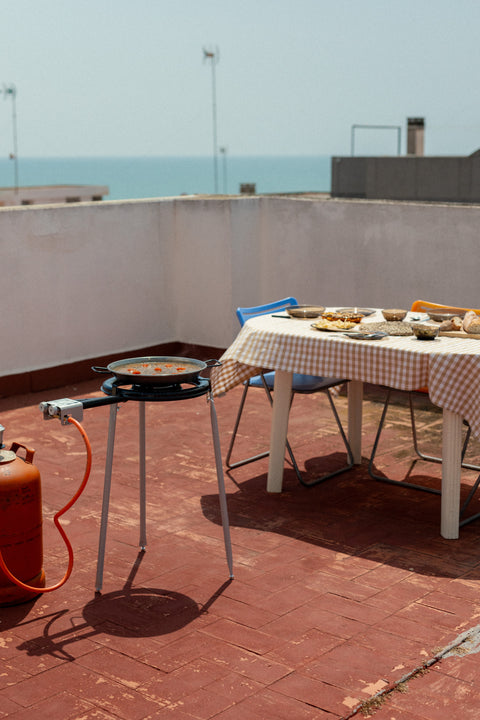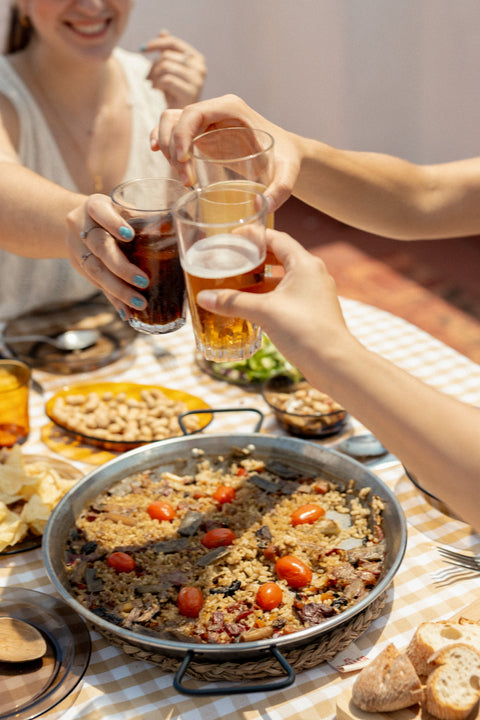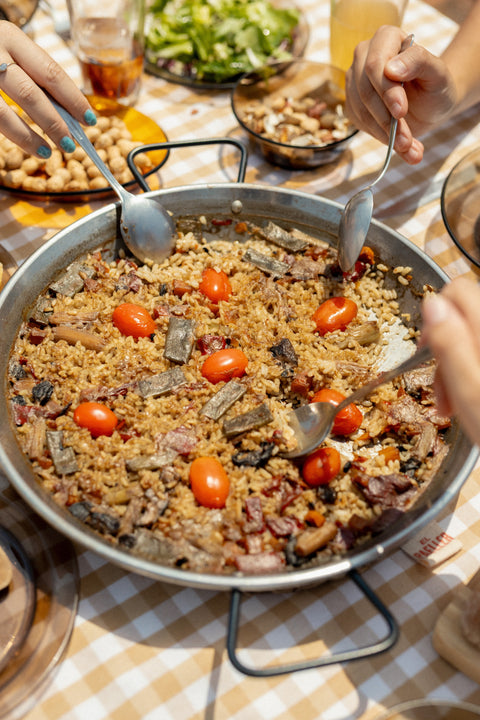If there's one dish that truly represents Spain, it's undoubtedly paella. But beyond the sofrito, the broth, and the star ingredients, there's one detail that makes all the difference between a spectacular paella and a disappointing one: the rice. And not just any rice will do for this delicacy.
So,What is the best rice for making paella?Next, we'll tell you which varieties work best and why. Let's get started!
The importance of choosing the best rice for paella
Why is the type of rice key to a perfect paella?
The type of rice determines how it will behave during cooking and how it will absorb the flavors of the broth. Short-grain rices, such as Bomba, are especially valued for their ability to retain liquid without losing their shape. This results in a firm yet tender texture, ideal for paella. Similarly, these rices have a high starch content, which allows them to better integrate flavors.
On the other hand, using the wrong type of rice can ruin all your efforts. Long-grain or aromatic rices tend to be less absorbent and can result in a bland paella or one with sticky grains. That's why choosing the right rice is so important. type of rice for paella The right ingredients are essential to ensure that every bite is an explosion of flavor.
Characteristics of the ideal rice for paella
The best rice for making paella It should be short-grained and round, as this type has a greater capacity to absorb broth and flavors. It should also be resistant to overcooking, maintaining its shape and texture even after long periods on the heat.
Another key characteristic is uniformity. The grains must be homogeneous in size and shape to ensure even cooking. This improves the dish's presentation and its texture.
Finally, good rice should also have a pearly appearance due to its starch content. This is crucial for giving paella its characteristic flavor when cooked correctly.
Types of rice for paellaWhich one is the best?
Albufera Rice: perfect balance between flavor and texture
At El Paeller we recommend the Albufera riceThis variety is a cross between Bomba, Senia, and Bahia rice. This combination offers the best of each: the absorption capacity of the traditional varieties (Senia and Bahia) and the cooking resistance of Bomba.
The Albufera rice grain has a creamy center and a firm exterior, allowing it to absorb broth very well while maintaining its structure without becoming overcooked. This makes it a truly exceptional rice. ideal for dry paellaswhere the balance between flavor and cooking point is everything.
Bomba rice: resistant, but less expressive
He Bomba rice It is highly valued for its ability to maintain its shape even during prolonged cooking. It has an "accordion" behavior: it expands as it absorbs liquid, but shrinks back down as it cools, making it very useful for less experienced cooks.
However, It absorbs less flavor than other varieties. like the Albufera, and that's why it's not always the first choice for those seeking maximum flavor intensity in every bite.
Senia and Bahía rices: pure intensity
Although less internationally known, the Senia and the Bay These are two traditional varieties cultivated in the Valencian Community. Their high amylopectin content allows them to absorb a large amount of broth, resulting in flavorful rice dishes.
However, they do require precision: They are more sensitive to the cooking pointA lapse in the heat or time can easily cause them to overcook, which is why they are usually in the hands of expert cooks or those who have mastered their paella.
Marisma Rice: the perfect ally for creamy and soupy rice dishes
He Marsh rice It is a round grain variety, with a very high absorption capacity, which makes it the ideal choice for dishes where broth is the main ingredient: creamy rice dishes, soupy rice dishes and risottos.
Its texture is soft and creamy, and its internal structure tends to release more starch during cooking, which adds density and lightness to the dish. However, it's not suitable for dry paellas, as its tendency to release starch can prevent the grains from remaining loose and separate, as required for this type of recipe.
Therefore, if you're preparing a lobster rice dish, a rice with a crust, or a Mediterranean-based risotto, Marisma is an excellent partner. But if we're talking about authentic Valencian paella, it's best to opt for varieties like Albufera.
Can you make paella with other types of rice?
Technically, you can make paella with other types of rice if you don't have access to specific varieties like Albufera or Senia. Believe us, in this industry, we've seen it all—even paellas made with basmati! However, you must be very careful with the proportions and cooking times. Long-grain or aromatic rices will not absorb flavors in the same way, nor will they have the same texture.
So, if you decide to experiment with other types of rice for paella, be sure to adjust the amount of broth and constantly monitor the cooking process to avoid unwanted results.
Factors to consider when choosing he best rice for paella
Origin and quality of rice: why does it matter?
Believe it or not, the place where rice is grown can significantly affect its flavor and texture. Rice grown in Valencia, for example, has a protected designation of origin due to its unique characteristics: a uniform grain, high starch concentration, and excellent liquid absorption capacity. Therefore, choosing it guarantees authenticity and quality.
Differences between domestic and imported rice
When it comes to preparing an authentic Valencian paella, the difference between the rice grown here and that from elsewhere is greater than it seems. Local rice, especially that grown in Valencia, has its own unique qualities: the climate and soil produce a firmer grain with better absorption capacity.
Imported rice, while not bad, usually has less starch and doesn't absorb broth as well. This can make your paella less flavorful or the rice stickier.
Where to buy the best rice for making paella?
To guarantee maximum quality, in our store you will find a wide variety of national alternatives, grown in the best conditions so that their authenticity and flavor are impeccable.

Tips for cooking paella with the perfect rice
Amount of broth according to the type of rice
Each type of rice for paella Each type of rice absorbs broth differently, so the quantities need to be adjusted accordingly. For example, Bomba rice needs more liquid, around 3.5 parts broth to one part rice. Varieties like Senia and Bahía, on the other hand, require slightly less, between 2.5 and 3 parts broth to one part rice, to achieve the ideal texture.
Ideal cooking time for each variety
Cooking time also varies depending on the type of rice you use: while bomba rice takes about 18-20 minutes to cook properly, other varieties like senia may require less time due to their lower resistance.
However, always keep in mind that, whatever the type, the trick is to start with high heat for the first few minutes, then reduce to medium, and finish with low heat for a delicious result. And don't forget to let it rest for about 5 minutes before serving.
Should the rice be washed before making paella?
Here comes the age-old debate: should you wash the rice before making paella? The truth is, it all depends on what you're looking for. If you wash it, you remove some of the starch, which helps the grains stay separate and prevents them from clumping together. But on the other hand, you also lose some flavor and a few nutrients.
And if you decide not to wash it, the rice will absorb the broth better and have a more intense flavor, although the texture might be a little stickier. So, in the end, the decision is yours: do you prefer looser rice or rice with more flavor? It's up to you!
Ultimately, the rice you choose will make all the difference in your paella, giving it that authentic touch that makes it irresistible. And if you want to ensure you use quality ingredients, take a look at our website. At El Paeller, you'll find everything you need. ingredients Everything you need to cook like a true paella pro. Order now and bring the taste of Spain to your table!







